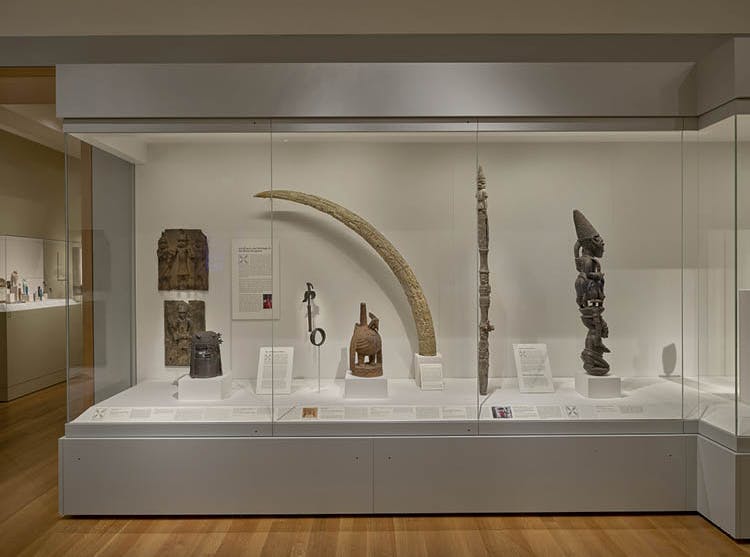
- Magazine Article
- Collection
Art from the Benin Kingdom
A new installation of a group of works sparks conversations about collecting and exhibiting

The gallery installation groups works by artistic guild and with allusions to original viewing context.
This fall, the CMA highlights works from the Benin Kingdom in the African arts gallery (108A). This in-gallery feature considers the complex acquisition history of and artistry behind eight works acquired by the museum between 1938 and 1999. Displaying these historical works together for the first time along with their provenance, the installation seeks not only to underscore their physical beauty and continued cultural importance, but also to bring them (and the CMA) into present-day conversations about collecting and exhibiting African arts.
Art, Power, and Heritage
The Benin Kingdom (or Ẹdo, located in present-day Nigeria) centers its political, religious, and social life around the Ọba (divine king). Its courtly rituals and arts have legitimized and empowered the Ọba from its 10th-century foundation through today. Ọbas commission artworks from artisan guilds and give others the right to own or commission them. As they do now, these male artisans likely collaborated to serve the royal court. Works by the guilds of brasscasters (Igun Eronmwon) and wood and ivory carvers (Igbesanmwan) are displayed in this installation.
Benin royal art uses symbolic materials that correspond with the status of its owner or dedicatee. Elephants are associated with wisdom, longevity, and leadership; like ruling dynasties, their ivory is hard and durable. An ancestral altar tusk that Oba Osemwede commissioned in the 1820s (1968.284) demonstrates this symbolism. It is covered by scenes of regalia-wearing royals (a Queen Mother), of ritual (a charm-bearing attendant), and of royal power (a kingly metaphor in the form of pouncing leopards). Wood was reserved for lesser elites; a realistically carved hen on view (1973.221) was made for a woman’s ancestral shrine.
Metalworks signaled prosperity, power, and skill. Valued for its reddish, shiny surface, brass is considered both beautiful and threatening. Benin gained brass through trade: European currency rings (manillas) were exchanged for people that Ẹdo enslaved in wars. Cast by guild members, an uhunmwun-elao (ancestral commemorative head) (1938.6) was among the objects a new Ọba commissioned for his predecessor’s shrine. While these represent an individual, their facial features and expressions were idealized. This uhunmwun-elao wears necklaces, a netted cap, and braid adornments that echo real-life coral examples.
After the 1897 Siege of Benin, most reasons for art making ceased with the Ọba’s exile. In 1914 Ọba Ẹwẹka II initiated reforms that changed who could own art. Today’s guild members create works for both royal and nonroyal buyers, preserving and innovating upon their artistic heritage. Now led by Ọba Ewuare II, Benin remains a vibrant and vital contemporary kingdom.

Provenance and the Legacy of the Siege of Benin
The once-powerful Benin Kingdom had declined by the late 1800s, and the British sought to economically control or colonize it. British soldiers conquered Benin City on February 18, 1897, attacking and looting for days. The Ẹdo people fled and Ọba Ovọnramwẹn surrendered into exile. A “punitive expedition” in British military terms, this violence is recognized today as a siege and massacre.
Some seized objects were taken as war booty and others sold locally, while still others were auctioned in England to pay for the siege. Of the some 4,000 looted works, five eventually came to the CMA. The origins of three others here are under review. Today, most historical Benin Kingdom works are outside Nigeria. Western museums have been called on to acknowledge this theft and respond to requests for repatriation, restitution, or title transfer. For the first time, the CMA recognizes this history and provenance in its galleries.
Provenance is an artwork’s life story, from its maker to its present location. Since January 2020, the provenance of each Benin Kingdom work at the CMA has been extensively researched in advance of its reinstallation; any updates will be posted in Collection Online. Both this research and the works’ re-presentation have benefited from collaboration between CMA departments and with colleagues in Nigeria, the UK, Germany, and the US.
We display these works to celebrate the Benin Kingdom’s artistic heritage, and with respect for vital conversations about its future. These discussions have many stakeholders, including the Ọba and the Nigerian government (who both claim the works), as well as the public. Dialogue is key between these parties and institutions holding objects from the Benin Kingdom.
The Installation
Several curatorial and design elements inform this presentation. Works are grouped by artistic guild, and installed with allusions to their original viewing context. New labels consider these works from art historical, cultural, and postcolonial perspectives. One wall panel discusses the kingdom’s artistry; another addresses the Siege of Benin and present-day discussions about returns; a third explains provenance. Fresh contextual images emphasize the kingdom’s longevity, with a pre-siege photograph as well as recent images taken by Nigerian artist Victor Ehikhamenor.
A signature motif created by CMA graphic designer Natalie Maitland echoes the unique cast brass plaques from which it draws. The four-petaled flowers are ebe-amẹn (river leaves). They are linked to Olókun, god of the waters, whose priestesses use such leaves for healing. In Ẹdo belief, water separates the lands of the dead and the living. Ebe-amẹn are fitting symbols for an installation reflecting on both past and present with an eye toward future healing, and for artworks that connect living people with their ancestors.
Cleveland Art, Winter 2021